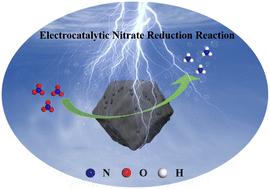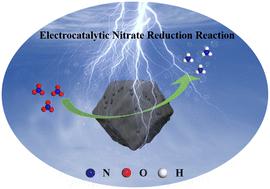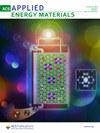促进电催化硝酸盐还原成氨的镍负载 Co-NC 催化剂
IF 5.4
3区 材料科学
Q2 CHEMISTRY, PHYSICAL
引用次数: 0
摘要
哈伯-博施工艺是合成氨的传统方法,使用的氢气来自碳氢化合物的蒸汽重整;并且涉及高温(300-600 °C)和高压(200-400 atm)的苛刻操作条件,每年消耗大量能源。最近,人们对电化学还原氮过程(NRR)转化为 NH3 产生了浓厚的兴趣,这一过程受到了自然界微生物固氮作用的启发。然而,稳定的 NN 剧烈氢进化反应阻碍了 NRR 的发展。相比之下,电催化硝酸盐还原反应(NO3RR)具有显著优势。NO 所需的解离能(204 kJ mol-1)要低得多;硝酸盐在地表水中广泛存在。本文报道了一种通过简单浸渍法将镍负载到 CoZn@ZIF 上的电催化剂,该催化剂在热解碳化后具有掺氮石墨碳结构。详细实验表明,与 Co-NC 相比,NiCo-NC 催化剂能显著加速 NO3RR 的生成。NiCo-NC 具有显著的 NO3RR 活性。在 -0.6 V 和 -1.1 V 下,氨产量分别为 5.01 mg cm-2 h-1 和 10.12 mg cm-2 h-1,FE 分别达到 92.75% 和 96.65%。在 24 小时电解实验和五次循环稳定性测试中,催化剂表现出优异的电化学稳定性。同时,15N 同位素标记实验进一步验证了 NH4+ 中的 N 来源于 NO3-。本文章由计算机程序翻译,如有差异,请以英文原文为准。


Ni-loaded Co-NC catalysts for promoting electrocatalytic nitrate reduction to ammonia†
The Haber–Bosch process, the traditional method of ammonia synthesis, uses hydrogen derived from steam reforming of hydrocarbons; and involves harsh operating conditions of high temperatures (300–600 °C) and pressures (200–400 atm), expending a vast amount of energy each year. Recently, there has been a lot of interest in the electrochemical nitrogen reduction process (NRR) to NH3, which is inspired by natural microbial nitrogen fixation. However, the stable NN violent hydrogen evolution reaction hindered the development of the NRR. In comparison, the electrocatalytic nitrate reduction reaction (NO3RR) has significant advantages. The much lower dissociation energy of NO (204 kJ mol−1) is required; nitrate is widespread in surface water. Herein, an electrocatalyst loaded with Ni onto CoZn@ZIF by a simple impregnation method is reported, which possesses a nitrogen-doped graphitic carbon structure after pyrolytic carbonization. Detailed experiments showed that the NiCo-NC catalyst significantly accelerated the NO3RR compared to Co-NC. NiCo-NC exhibited remarkable NO3RR activity. At −0.6 V and −1.1 V, ammonia yields of 5.01 mg cm−2 h−1 and 10.12 mg cm−2 h−1 were obtained, with FEs reaching 92.75% and 96.65%, respectively. The catalyst showed excellent electrochemical stability in 24-hour electrolysis experiments and five-cycle stability tests. Meanwhile, 15N isotope labeling experiments further verified the source of N in NH4+ from NO3−.
求助全文
通过发布文献求助,成功后即可免费获取论文全文。
去求助
来源期刊

ACS Applied Energy Materials
Materials Science-Materials Chemistry
CiteScore
10.30
自引率
6.20%
发文量
1368
期刊介绍:
ACS Applied Energy Materials is an interdisciplinary journal publishing original research covering all aspects of materials, engineering, chemistry, physics and biology relevant to energy conversion and storage. The journal is devoted to reports of new and original experimental and theoretical research of an applied nature that integrate knowledge in the areas of materials, engineering, physics, bioscience, and chemistry into important energy applications.
 求助内容:
求助内容: 应助结果提醒方式:
应助结果提醒方式:


